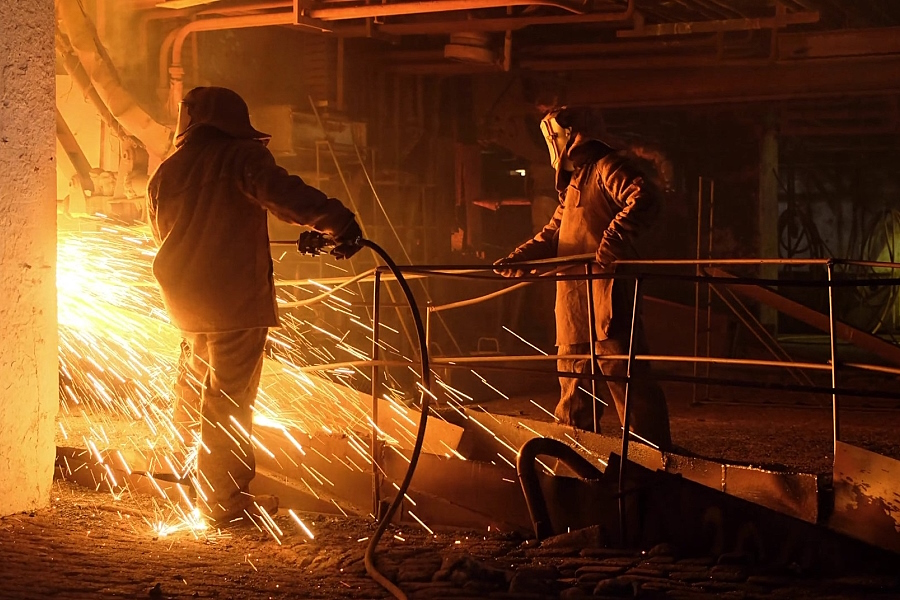Modernization and equipment of metallurgical plants: financing and loans
GCAM Investment Group offers:
• Investment financing from €50 million and more
• Minimizing the contribution of the project promoter
• Investment loan term up to 20 years
• Loan guarantees
To maintain competitiveness and meet evolving standards, these plants often require modernization and the acquisition of equipment. However, such initiatives come with substantial financial implications.
GCAM Investment Group offers comprehensive strategies for financing the modernization and equipment of metallurgical plants, focusing on loans and project finance (PF) options.
Overview of metallurgical plant modernization
There are numerous approaches to increase the competitiveness of the steel industry in world practice.These include optimization of material and energy consumption, focus on innovative technologies and high-tech equipment, improving the quality and expanding the range of metallurgical products, as well as emission reduction.
Reasons for modernizing metallurgical plants include the following:
• Imperfect structure of steel production.
• Backward and insufficiently effective technologies.
• High material consumption and energy intensity of production.
• Rapid aging and wear of steel production machinery.
• Environmental risks, etc.
The issue of increasing the competitiveness of steel production is of interest to leading engineering companies, steelmakers and investors. Due to increasing demands and standards, costs of equipment modernization may exceed 80-100 euros per 1 ton of steel produced.
Upgrades can include electronic equipment, handling systems, conveyors, blast furnaces, boilers, heat recovery units, and more.
As a rule, we are talking about expensive equipment worth tens of millions of euros, which requires the external sources of financing on a long-term basis.
Our task is to make the modernization efficient and affordable for our clients. Together with our international partners, we offer customized financial solutions along with professional engineering services.
Key drivers of investment in production upgrades
As we can see, modernization of metallurgical plants is crucial for various reasons, and its importance extends across different facets of industrial operations. Below we have proposed a closer look at the key drivers of this process.Addressing technological obsolescence
Metallurgical processes, equipment, and technologies evolve over time.Aging infrastructure and outdated machinery can lead to inefficiencies, increased maintenance costs, and decreased overall productivity. Modernization involves replacing obsolete technologies with state-of-the-art solutions. This not only ensures that the plant remains competitive in the market but also allows it to benefit from the latest advancements in metallurgical science and engineering.
Enhancing production efficiency and capacity
Modernization initiatives often focus on improving the efficiency and capacity of production processes. Advanced automation, control systems, and optimized workflows contribute to streamlined operations, reduced downtime, and increased output. By incorporating cutting-edge technologies, metallurgical plants can achieve high levels of precision, consistency, and speed in their production processes. This positively impacts the overall productivity and competitiveness of the plant in the global market.Meeting environmental and safety regulations
Compliance with environmental and safety regulations is a paramount concern for metallurgical plants.Outdated facilities may not meet current environmental standards, leading to potential legal and reputational risks. Modernization efforts often include the implementation of eco-friendly practices, new waste reduction measures, and the adoption of cleaner technologies. Moreover, the integration of advanced safety features and protocols enhances worker well-being, reduces the likelihood of accidents, and ensures compliance with stringent safety regulations.
The importance of modernization in metallurgical plants lies in its ability to keep pace with tech advancements, improve operational efficiency, and align with evolving environmental and safety standards.
By addressing these crucial aspects, steel producers can not only stay competitive but also contribute to sustainable industrial practices.
Key areas of metallurgical plant modernization
Modernizing metallurgical plants involves targeted improvements in various areas to enhance efficiency, reduce environmental impact, and ensure compliance with evolving industry standards. Upgrading smelting and refining processes, implementing advanced automation and control systems, and adopting eco-friendly practices are critical components of modernization of large steel producing facilities.Table: The most important areas of metallurgical plant modernization
| Key directions | Areas of modernization | Brief description |
| Upgrading smelting and refining processes | Technology integration | Incorporating advanced technologies for smelting and refining processes helps improve the quality and purity of metal output. This may include the adoption of advanced furnaces, converters, and refining equipment. |
| Energy efficiency | Upgrading smelting and refining processes often involves optimizing energy consumption. Utilizing energy-efficient technologies and implementing process modifications can result in cost savings and reduced environmental impact. | |
| Resource recovery |
Modernization can focus on recovering valuable by-products from the smelting and refining processes, enhancing overall resource utilization and reducing waste. |
|
| Implementing advanced automation and control systems | Process optimization | Advanced automation systems enable real-time monitoring and control of metallurgical processes, ensuring optimal performance and consistency. Automation enhances precision, reduces human errors, and improves production efficiency. |
| Data analytics | Implementing data analytics and machine learning technologies allows plants to analyze large datasets, identify patterns, and optimize production processes. Predictive maintenance can also be implemented to reduce downtime. | |
| Integration of robotics | The integration of robotic systems in metallurgical processes, such as material handling and quality control, can lead to improved efficiency, safety, and overall plant performance. | |
| Adopting eco-friendly and sustainable practices | Emission reduction | Metallurgical plants are often associated with high emissions. Modernization efforts may involve adopting technologies to reduce greenhouse gas emissions, such as the implementation of carbon capture and storage (CCS) systems. |
| Water conservation | Sustainable practices include the efficient use of industrial water resources and the implementation of water recycling systems. This not only addresses environmental concerns but also contributes to significant cost savings. | |
| Waste management | Modernization aims to minimize waste generation and enhance the recycling of by-products. Implementing advanced waste treatment technologies can mitigate the environmental impact of metallurgical operations. | |
| Renewable energy technology integration | Transitioning to renewable energy sources, such as solar or wind power, can reduce the carbon footprint of metallurgical plants and contribute to a more sustainable energy mix. |
The above-mentioned various activities not only enhance operational efficiency but also contribute to environmental sustainability, aligning steel industry with evolving global business expectations and regulatory requirements.
Financial considerations: step-by-step approach
Modernizing large metallurgical plants involves significant financial commitments and navigating various challenges.Understanding and addressing these financial considerations are crucial for the success of the modernization initiative. Below are listed main financial challenges and considerations associated with modernization project.

Cost analysis
Modernizing a metallurgical plant requires a meticulous approach to budgeting. Beyond the acquisition costs of new equipment, a detailed budget must encompass engineering, construction, project management, training, and potential contingencies. A comprehensive financial plan is essential to avoid cost overruns and ensure project success.Beyond initial investment, considering the total lifecycle costs of the modernization is critical. This includes maintenance, operational, and potential upgrade costs over the lifespan of the upgraded equipment and systems.
Risk assessment
Navigating the uncertainties associated with modernization involves comprehensive risk assessment. Market volatility, technological risks, and regulatory compliance uncertainties can impact the financial viability of the project.Identifying potential challenges and formulating mitigation strategies is crucial for minimizing risks and ensuring the smooth progression of the modernization initiative.
This includes the following:
• Market volatility: The steel industry is often susceptible to market fluctuations, affecting commodity prices and demand. Assessing the potential impact of market volatility on project viability is essential for risk mitigation.
• Regulatory compliance risks: Evolving environmental and safety regulations can impact the financial viability of a project. Ensuring compliance with regulations is crucial to avoid fines and operational disruptions.
• Technological risks: Adopting new technologies in steel industry carries inherent risks, including operational disruptions, unforeseen technical challenges, and the need for additional training.
Return on Investment (ROI)
Understanding the expected return on investment is a crucial aspect of financial planning for modernization projects. Timely ROI analysis helps decision-makers gauge when the project is likely to break even and start generating positive returns. This financial metric is used for assessing the overall feasibility and results of the effort.Calculating the expected return on investment is vital for decision-making. Understanding when the modernization project is likely to break even and start generating positive returns helps in assessing its financial feasibility.
Besides financial returns, quantifying non-financial benefits such as improved operational efficiency, reduced environmental impact, and enhanced safety is essential for a comprehensive ROI analysis.
Financing options
For metallurgical plants seeking financing options, understanding the intricacies of loans is essential.This involves examining interest rates, repayment terms, and potential collateral requirements. A clear understanding of financing terms ensures that the chosen financial arrangement aligns with the steel producer's financial capacity.
Exploring available government programs and incentives for industrial modernization can also significantly alleviate financial burdens. Understanding eligibility criteria and application processes is vital for accessing these funds. Entering into partnerships with private investors involves careful consideration of equity stakes, profit-sharing arrangements, and the impact on the metallurgical plant's ownership structure.
Resource allocation and prioritization
Modernization projects in steel industry often necessitate external funding, and exploring various financing options is a critical step.This includes assessing government grants and subsidies, understanding private equity and venture capital partnerships, and considering traditional bank loans. Diversifying funding sources and selecting the most suitable financing option are crucial components of the financial strategy for metallurgical plant modernization.
Optimal planning for a metallurgical plant modernization project is based on two important principles:
• Optimizing resource allocation: Efficiently allocating financial resources across different aspects of the modernization project is crucial. Balancing investments in advanced technologies, human resources, and compliance measures contributes to overall project success.
• Prioritizing critical upgrades: Identifying and prioritizing critical upgrades that provide immediate benefits helps in phased implementation, allowing company to reap early rewards and manage financial risks.
The modernization and purchase of equipment for metallurgical plants represent key steps in maintaining competitiveness and sustainability. Navigating the financial aspects of these initiatives requires a strategic approach, considering various financing options and implementing effective financial management practices. By understanding the challenges and learning from successful cases, steel producers can ensure long-term success in today's market.
GCAM Investment Group is ready to help your team on this journey.
Contact our experts to find out more.




















